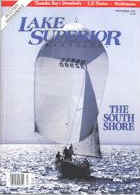
LAKE SUPERIOR MAGAZINE / AUGUST-SEPTEMBER 1990
Mushrooms
LAKE SUPERIOR'S GREAT
DECOMPOSERS
written and photographed
by MARK SAKRY
They have been associated with mystery and enchantment, sorcery and
witchcraft. They have been feared and disdained for centuries—spurned as
awful, lethal organisms which belong to the dark provinces of death and decay.
Mushrooms—Toadstoo/s!
Even their names roll off the tongue as if more fittingly accompanied by
the croak of a frog: Corpse Finder, Witch's Butter, Tree Brain, Devil's Urn …
Double, double toil and trouble!
But wait, what are these? Names which point to a loftier
province: Parasol, Angel's Wings, Fairy Ring, Chanterelle. Could it be that
mushrooms have held more exalted positions in the past?
Indeed, in many cultures mushrooms have been revered for centuries.
The Romans considered mushrooms "food of the gods" and believed they gave
warriors great strength in battle. In China, there was the "divine
fungus," ling chih. In Siberia, there was hango, which was considered
the shaman's "pathway to the gods." Teo-nanacatl was "god's
flesh" to the Aztecs. And the Egyptian pharaohs found mushrooms so appealing
they forbade the common people to eat them.
As elsewhere, fungi play a vital role in the ecosystems in and about
the Lake Superior region. If the lowly fungus does not appear to hold (or deserve)
its forthright status, at least consider that it belongs to one of the most important
cycles in the terrestrial environment: decomposition.
A complex system of organisms which includes fungi, decay bacteria,
earthworms, soil mites and millipedes, decomposers ensure the breakdown and distribution
of discarded plant energy after animal consumption. They help "digest" the
remains and convert it to a form usable by other living plants. Were it not for the
decomposers, the forests would literally fill up with debris.
Out of more than 100,000
known species of fungi worldwide, only about 7,000 produce the fruiting bodies we call
mushrooms. In the Lake Superior region, mushrooms appear most frequently during late
summer and fall, typically when dry summer weather has been followed by a good spell of
rain.
A short walk across
the sponge of any spruce-sphagnum bog during late summer can inspire deep contemplation,
whether you're predisposed to it or not. The diverse color and variety of mushrooms
against green is astonishing.
And who should not gasp at the waxy red dollop of a Scarlet Cup against
the litter of an old-growth forest in early spring? Or the blazing tendrils of a
Yellow Coral in balsam-filtered summer sunlight? Or an autumn sunset reflecting off
an impeccable cluster of creamy Oysters?
Out of almost 5,000 species of mushrooms found in the United States,
nearly two-thirds may be found in areas bordering the Great Lakes. Whether you
forage an open field, walk a tranquil forest path or marvel at your own lawn after a rain,
there is beauty to behold in mushrooms.
For those who wish to forage wild mushrooms, 100 are known to be
poisonous and 12 deadly. Although there are comparatively few poisonous mushrooms,
bring along an expert mushroom hunter, as well as reliable field texts (see those
recommended below), to determine which ones are safe to eat. Read and follow the
instructions given in all field guide appendices. If you do not know how to positively
identify a mushroom species, you should not eat any wild mushroom.
I'm for the inglorious fungi. They are associated far more with
life than with death. They are as interesting and diverse as the environments in
which they thrive. They possess enchantment and beauty.
In a nook on my bedroom book shelf stands a humble specimen of Fomes
applanatus, the "artist's fungus," upon which my wife has etched figures of
geese. Somehow I see this as a fitting image. For just as the return of geese
in spring symbolizes the renewal of life, so in its own lowly manner does the mushroom.
LSM
Mark Sakry is a resident of
Brimson, Minnesota. He previously contributed "Snowcamp" in our
February-March 1990 issue. He has also written for Minnesota Out-of-Doors,
Boundary Waters Journal and the Duluth News-Tribune.
Recommended Mushroom Field Guides
The Audubon Society Field Guide to
North American Mushrooms by Gary Lincoff (Alfred A. Knopf, $13.50).
Edible Mushrooms by Clyde M. Christensen (University
of Minnesota Press, $7.95).
The Mushroom Hunter's Field Guide by Alexander
Smith (University of Michigan Press, $14.95).
Mushrooms of North America by Orson A. Miller Jr. (ER
Dutton, $14.50).
Mushroom Pocket Field Guide by Howard E. Bigelow
(Collier Macmillan, $4.95).
LAKE SUPERIOR MAGAZINE / AUGUST-SEPTEMBER 1990
Copyright C. Mark Sakry 1990
Mushroom Photos and Captions
RELATED TOPICS
Edible Mushrooms: The Fruit of Fall Foragers
Mushrooms
Mushroom Recipes for the Trail
The Exotic Wild Leek
Foraging for Sea Food

